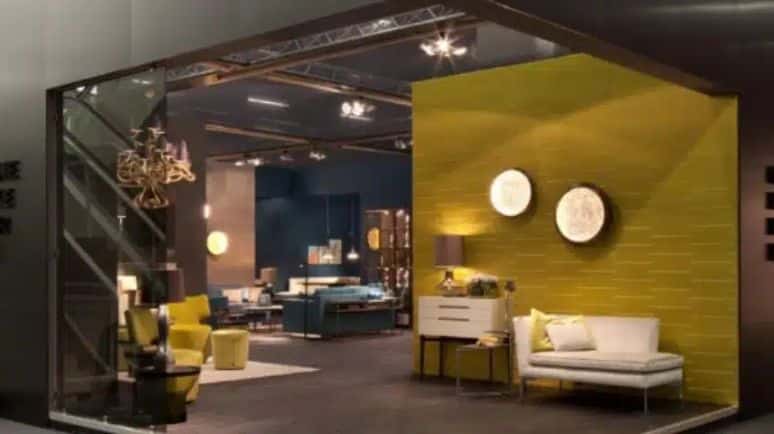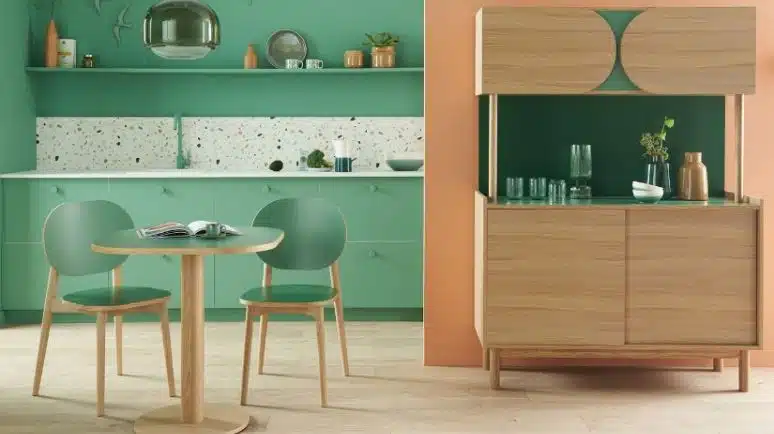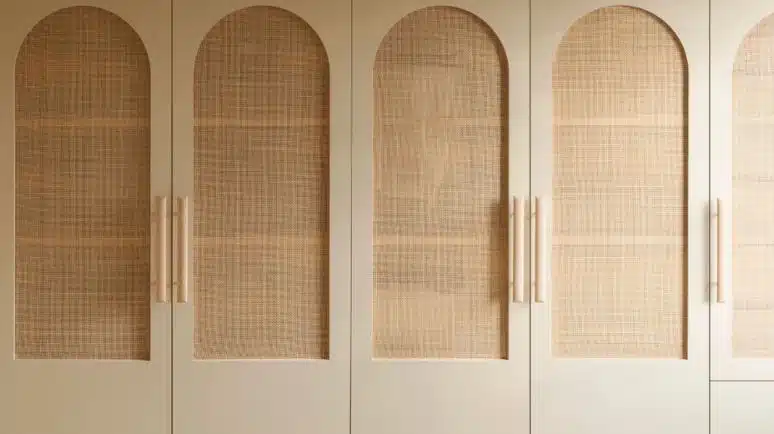
From Kitchens to Doors: How to Choose the Perfect Laminates for Every Space
October 21, 2025
The Aesthetic Edge: What Makes HPL Sheets a Designer’s Favourite
November 18, 2025Interior design has its celebrity materials, marble, hardwood, stone. Decorative laminates? They’ve quietly transformed surface design without much fanfare.
Walk through any renovated office, hotel, or apartment. You’re looking at laminates on countertops, cabinetry, wall panels. They’re everywhere because they work. Want marble looks without maintenance and cost? Laminate delivers. Need wood grain that won’t warp? Laminate handles it.
Residential projects use them heavily. Commercial spaces need their durability. Hotels specify them because rooms must survive thousands of guests.
This isn’t about laminates being “just as good” as premium materials. They solve different problems. Sometimes you need actual marble. Sometimes you need something that looks like marble, withstands spills, won’t stain, and costs less.
Laminates became fundamental to surface specifications by performing, not marketing. Let’s dive into this blog to know more about them.
What Are Decorative Laminates?
Decorative laminates are synthetic surfaces, paper or fabric layers soaked in resin, then pressed onto MDF or plywood under serious heat and pressure.
What you end up with is a durable surface looking like wood, stone, or pricey materials without being those materials. Without the price tags or upkeep nightmares either.
Design options? Huge. Wood grain mimicking oak or walnut. Stone patterns look like marble or granite. Solid colors. Metallic finishes. High-gloss that bounces light everywhere. Whatever look you need, there’s likely a laminate covering it.
This explains why designers and homeowners stick with them. Client wants oak cabinets but their budget caps out at $8,000? Laminate fixes that. Someone’s obsessed with concrete countertops but balks at sealing them twice yearly? Laminate handles it.
The material works because it’s actually practical, not just cheaper. Real marble stains when someone spills red wine. Real wood scratches from keys dragged across it and needs refinishing every three to five years. Laminates dodge both problems, cost maybe 40% of natural materials, and need nothing beyond normal cleaning. No fancy products. No maintenance contracts.
Why Decorative Laminate Sheets Designs Are a Game Changer?
Here are some of the factors to consider before choosing decorative laminate sheets designs:
1. Versatility in Design
Laminates come in basically every texture you need. Client wants marble? There’s a laminate that looks nearly identical. Oak? Covered. Finishes range from flat matte to mirror-shine.
Works in downtown apartments, farmhouses, mid-century homes, whatever style, there’s probably five options that’ll work.
We keep specifying them because you’re not stuck with two choices hoping one fits.
2. Durability and Easy Maintenance
Real wood scratches when you drag plates across it. Marble stains from orange juice. Laminates don’t. They also handle moisture that warps wood and ruins stone in bathrooms.
High-traffic spots, busy kitchens, restaurant prep areas, hotel desks, don’t destroy them like they do natural materials.
Maintenance is dead simple. Wipe with a wet cloth. Done. No annual sealing. No special cleaners. No refinishing every few years. For families with kids or commercial spaces getting beat up daily, this practicality matters more than “real” materials.
3. Affordability and Sustainability
Laminates cost way less than natural stuff. Marble countertops run thousands. Comparable laminate? Maybe a third of that.
Environmental angle improved too. Tons of manufacturers now use recycled materials and low-emission adhesives. Ten years ago finding eco-friendly laminates meant calling around forever. Now they’re standard.
4. Innovative Features
Modern laminates do more than look nice. Anti-bacterial surfaces kill germs, useful in hospitals or kitchens preparing raw chicken. UV-resistant finishes don’t fade in sunlight. I’ve seen countertops near south-facing windows still looking good after eight years.
Heavy scratch-resistant versions survive retail where customers touch everything constantly. These solve real problems. Medical facilities need surfaces bacteria can’t colonize. Stores need finishes that don’t look trashed after two years.
Laminates work because they’re affordable, survive actual use, and increasingly don’t wreck the planet. Way better than the flimsy fake-wood stuff from 1970s kitchens.
Types of Decorative Laminates and Their Benefits
Now, let’s dive deeper into some of the most popular decorative laminate texture types and how they’re transforming modern interior spaces.
1. Woodgrain Laminates
Wood Grain decorative laminate texture delivers wood aesthetics without maintenance headaches. Real wood scratches from daily use, gets water rings, needs refinishing every few years.
Woodgrain laminates capture grain patterns and warmth while eliminating upkeep. Clients get wood aesthetics without ongoing maintenance. No oiling. No polishing. Regular cleaning works fine.
2. Stone and Marble Laminates
Real marble costs heavily and stains from acidic liquids, lemon juice, wine, vinegar. Granite needs regular sealing and costs similarly.
Stone laminates replicate these materials well enough that observers can’t tell from across the room. High-gloss marble laminates suit bathroom vanities needing luxury appearance. Granite-look finishes work for kitchen countertops.
Spill red wine on laminate? Wipe clean. No worrying about permanent etching like actual marble causes.
3. Glossy and High-Gloss Laminates
High-gloss laminates provide the reflective finish seen in design publications. They distribute light better, making smaller spaces feel larger.
We specify these often in modern kitchens, upscale bathrooms, and corporate offices needing polished looks. They photograph well, which matters when clients care about presentation.
4. Textured Laminates
Smooth glossy surfaces don’t suit every project. Textured laminates, embossed patterns, matte finishes, provide depth you can feel.
These work well in living spaces emphasizing comfort over sleekness. Home offices benefit from the character textured surfaces added. The varied surface catches light differently than flat materials, creating interest smooth laminates don’t offer.
These finishes make ordinary spaces feel deliberately designed rather than simply functional.
Applications of Decorative Laminates
Laminates show up everywhere. Here’s where we use them most often:
- Furniture: Wardrobes, coffee tables, desks, decor laminates take daily abuse without falling apart fast. A laminate desk still looks decent after five years of coffee mugs, laptop bags, and people leaning on it. Natural wood? Scratched and dinged within the first year.
- Wall Panels and Cladding: Reception area accent walls, full lobby coverage, office feature walls. You get visual impact without dropping tens of thousands on wood paneling or stone installation. Client sees the wall, thinks of expensive materials. You know it’s a smart laminate specification.
- Cabinets and Countertops: Kitchen and bathroom counters in laminate look like stone or wood but cost maybe a third as much. They also handle water better than some natural materials that need constant sealing and maintenance. Granite needs resealing annually. Laminate? Wipe it down and move on.
- Commercial Spaces: Hotels, corporate offices, retail stores, surfaces in these places get touched by hundreds of people every single day. Front desk counters. Lobby walls. Retail checkout areas. These need to survive two years of constant contact without looking beat up. Laminates deliver that durability while still looking professional enough that guests and clients don’t think you cheaped out.
How to Choose the Right Decor Laminates
Choosing laminates for your project comes down to a few practical questions:
- Consider the Space: Where’s this actually going? Glossy laminates look sharp in modern offices or kitchens going for that slick contemporary vibe. Wood or stone patterns? Better for living rooms or hotel lobbies where you want people feeling comfortable, not like they’re in a showroom.
- Texture Matters: Surface texture completely changes room feel. Matte finishes give you that quiet, understated look, works great in law offices or corporate boardrooms. Glossy surfaces? They bounce light everywhere, making cramped spaces feel less claustrophobic. We throw these into small urban apartments all the time because you need every trick you can get to make 600 square feet feel livable.
- Durability Needs: How much beating will this surface take? Restaurant kitchens, busy family bathrooms, coffee shop counters, you need thick, bulletproof laminates surviving whatever gets thrown at them daily. Guest bedroom dresser or your personal home office desk? Standard grade works fine. Don’t overbuild where you don’t need to.
- Eco-Friendliness: Client actually cares about sustainability or just checking boxes? If they’re serious, spec laminates with legit environmental certifications, recycled materials, low-VOC adhesives, factories not dumping waste. Helps with LEED credits if that’s what you’re after. Some clients just want it because it matters to them personally, certification hunting aside.
Why Decorative Laminates Are a Game Changer
Laminates have genuinely changed how we approach interior surfaces. They replicate natural materials convincingly, survive years of actual use, and require almost no maintenance beyond regular cleaning.
This combination matters because most projects have budget constraints. Clients want marble aesthetics without marble prices. They need wood warmth without refinishing schedules. Laminates deliver both.
Whether you’re designing a modern kitchen, home office, or hotel lobby, laminates solve the practical problem of creating spaces that look good and stay looking good after years of use. Beauty at a reasonable cost with durability that actually lasts, that’s why they’ve become standard specifications across residential and commercial projects.
Conclusion
Decorative laminates became standard in modern interiors because they solve practical problems. They look good, survive actual use, and don’t cost what natural materials cost.
Homeowners on budgets, designers and decorative laminate manufacturers managing client finances both use laminates constantly. Not because they’re trendy, because they work. Need wood grain? Marble look? Contemporary gloss? Laminates cover all that while holding up over years of normal wear.
The maintenance piece matters more than people realize initially. Surfaces that survive daily life while needing just a wipe-down solve real headaches for families with kids or commercial spaces getting hammered constantly.
Walk into a sharp-looking space with surfaces that seem expensive. Good chance laminates are behind that appearance, doing the work quietly while costing a fraction of what those surfaces look like they should cost.
FAQs
Paper or fabric layers soaked in resin, pressed onto MDF or plywood under serious heat and pressure. The resin cures hard during manufacturing. That’s basically what you’re getting, layered material bonded to a backing board.
Wipe them down with a wet cloth. Done. Something spilled and sticky? Use a little dish soap. That’s literally all the maintenance required. No sealing. No polishing. No special cleaners you have to buy. Compare that to maintaining real wood or marble, laminates are way simpler.
Some are, some aren’t. Lots of manufacturers make green versions now, recycled materials, low-VOC glues, that kind of thing. Wasn’t true ten years back when finding eco-friendly laminates meant endless phone calls. Now most big brands carry them as regular options. If environmental stuff matters for your project, just ask for certifications when you’re ordering.




